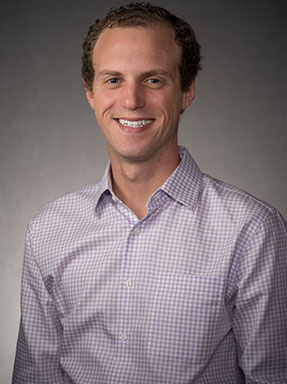Chemist Fights Tuberculosis, Aids Future Scientists With Grant
John Latham’s CAREER award funds his lab’s research and sponsors an eighth-grade biochemistry club

Take a guess: Before COVID-19 reared its ugly head, what was the deadliest disease in the world?
The correct answer is tuberculosis, which killed more than 1.5 million people in 2020, while the current pandemic hogged the spotlight. Indeed, tuberculosis claimed more than 1 billion lives over the past 200 years, and more than one-third of the global population has it, whether in fatal or latent form.
John Latham, an associate professor in the University of Denver’s College of Natural Science and Mathematics, is hoping his research can slow this deadly disease. With a new CAREER grant from the National Science Foundation, Latham and his on-campus lab are studying ways to prevent tuberculosis bacteria from growing strong enough to survive and thrive inside the body.
“It’s another cog in the machine that will ultimately find something to defeat this pathogen,” Latham says of his work. “We all contribute to the bigger goal. That bigger goal might be a deeper understanding of human physiology. That bigger goal might be a deeper understanding of bacterial physiology, but we’re all contributing to it. And I feel like my part in the realm of society is contributing to a better understanding of microbacterial physiology and natural product synthesis.”
When the tuberculosis bacteria (known as Mycobacteria) enters the body, the immune system responds by sending cells, known as macrophages, to envelop and destroy it. The macrophage swallows the invader and creates a sort of acidic bubble, which normally cracks open the intruder, leaving its content to be devoured by the body’s enzymes.
But, Latham says, “Tuberculosis evolved to withstand this acidic environment. It sits in this acidic environment, and it is happy as can be.”
The macrophages—with cell walls made of fats and cholesterol—actually feed the tuberculosis bacteria and help it proliferate, he says. One particular molecule in the bacteria, known as mycofactocin, plays a major role in allowing tuberculosis to chow down and gain strength.
If Latham and his team of undergraduate and graduate students can better understand mycofactocin and how it influences the bacteria’s behaviors, they have the opportunity to create a molecule that could make it difficult for tuberculosis to “eat” and gain strength. Doing so could inspire new treatments that could reduce fatality rates.
“Getting this CAREER allows me that freedom of curiosity to pursue this line of reasoning that probably wouldn’t be funded by the NIH,” Latham says. “For me, on a foundational level, it’s as good as gold.”
The five-year grant pays for a research position in Latham’s lab and helps fortify the future of science. With the money from the CAREER, Latham can sponsor a collaboration with Denver’s DSST Public Schools, which focus on science, technology, engineering and mathematics.
Colin Haverkamp's biochemistry club stands to benefit. The funding allows students in grades 8-12 to experience a more authentic lab setting, which Haverkamp hopes will draw them to the sciences well beyond high school. Plus, every summer, Haverkamp can study Latham’s lab to keep his skill set sharp.
“It’s a way for us as teachers to keep up and it’s also a way for students to really latch onto and get excited about things they’re going to love for the future,” Haverkamp says. “I think it’s a great partnership. I think John has done a really great job over the years of partnering with DSST and giving a lot of our students a lot of opportunity. We’re lucky to have that relationship.”
The relationship is just as important to Latham, who taught high school prior to his work in higher education.
“That outreach is probably just as valuable as my personal curiosity,” he says, especially because he feels that the United States is having a hard time recruiting scientists from within.
“And some areas of our population are super underrepresented,” like women and ethnic minorities, he says. “That’s not kosher, man. We’ve gotta get more diverse populations in science. It can’t just be a bunch of white guys. I don’t think you can put a price on getting good future scientists interested in science.”











